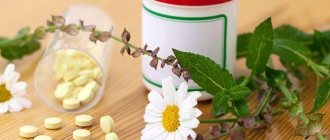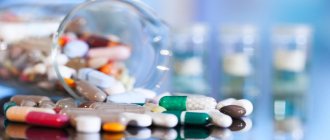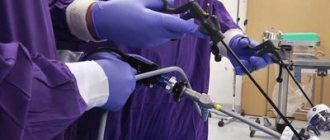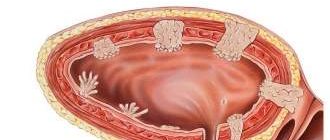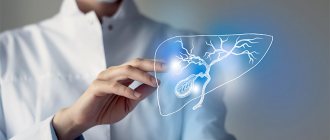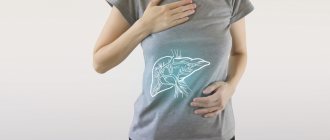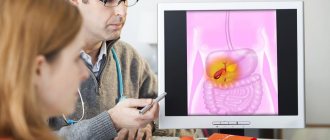Pain on the right side of the body may appear if the gallbladder, liver, stomach, pancreas or intestines are not in order. The most intense pain occurs with biliary colic and it is difficult to relieve. In order not to start a pathological process in the gallbladder, it is important to contact a gastroenterologist at the first painful sensation.
That is why it is necessary to know where a person’s gallbladder is located. And since pain in pathologies can radiate and be felt not only in the area of projection, you also need to know the functions of the gallbladder in the body in order to recognize the disease by other symptoms.
The role of the gallbladder in the body
Together with the ducts, the gallbladder forms the biliary system, which ensures the accumulation, storage and secretion of bile¹.
Bile is a digestive fluid that performs several functions:
- ensures the decomposition and absorption of fats;
- regulates the activity of intestinal enzymes and pancreatic enzymes;
- has bactericidal properties;
- activates small intestinal motility;
- participates in excretory processes.
Bile is secreted by the liver, and the gallbladder only stores it. The human liver can produce from 500 to 1000 ml of bile per day. It enters the gallbladder through the duct system. It holds about 50 ml of bile. Every time a person eats and food enters the duodenum, the walls of the gallbladder contract and bile is released into the intestinal lumen.
Where is the gallbladder located?
The gallbladder is located in the right hypochondrium under the liver (Fig. 1.). It fits tightly to it on the lower side and comes into contact with the stomach, small intestine, and the lining of the abdominal cavity. The gallbladder is connected to the liver by a duct through which bile moves. This is a small organ; normally it cannot be felt².
Figure 1. Location of the gallbladder. Source: Cancer Research UK / Wikimedia Commons (CC BY-SA 4.0)
Structure of the gallbladder
The gallbladder is a relatively small, pear-shaped, sac-like organ. The volume of the organ is 40-60 cm3, its length is from 8 to 12 cm, width from 3 to 5 cm. The length of the cystic duct is about 3.5 cm. The structure of the gallbladder is divided into a body, a neck and a fundus. The bottom forms the lower part of the bladder and protrudes slightly from under the liver. It passes into the middle part of the organ - its body. The body tapers upward, forming a neck, the narrowest part. It connects to the cystic duct, which in turn opens into the common bile duct. The edge of the organ in the cervical area is located at an angle to facilitate the outflow of secretions. The ducts have sphincters - muscle valves that open when the outflow of bile begins, prevent its reverse flow (throwing the contents of the duodenum into the gallbladder), and also block the flow of secretions when the digestion process is completed (Fig. 2).
Figure 2. Structure of the gallbladder and bile ducts. Source: OpenStax (CC BY 4.0)
The wall of the gallbladder has three layers or membranes. The outer connective tissue membrane performs protective functions. The muscularis propria forms the main layer of the walls. It is needed to contract the organ during the release of bile. The mucous membrane forms folds that straighten when the bladder fills. In the area of the neck and cystic duct, these folds are arranged in a spiral. This is necessary to improve the excretion of bile.
In what cases is surgery justified?
The gallbladder plays an important role in the body, and its removal introduces an imbalance and forces the entire digestive system to rebuild. Therefore, the doctor tries to the last to preserve this small but so important organ. The decision to remove it is made only when its preservation threatens the patient’s life. Blockage of the ducts by stones can lead to rupture of the gallbladder and inflammatory damage to other organs - the liver, diaphragm, and intestines. The growth of polyps by 2 mm per year also indicates the possible degeneration of benign polyps into a life-threatening oncological tumor, and is therefore an indication for surgical intervention.
Functions of the gallbladder
Bile is constantly produced by the liver, but it is needed only during digestion, while food is in the stomach. The rest of the time it accumulates and is stored in the gallbladder². In this case, the body performs several functions:
- Reservoir. During periods when digestion does not occur, bile gradually accumulates inside the gallbladder.
- Tow truck. During digestion, bile is released and moves through the ducts into the lumen of the duodenum.
- Concentration. When bile accumulates, it gradually thickens, and the concentration of acids changes so that the secretion does not damage the mucous membrane of the digestive tract and ensures the breakdown of lipids. This is necessary, for example, if a person does not eat for a long time and there is no outflow of bile.
- Absorption. The walls of the organ absorb excess fluid, due to which the concentration of the secretion increases. It is possible to absorb not only liquid, but also other components contained in excess in bile.
- Secretory. The glands in the neck of the gallbladder secrete mucus, which is necessary for the movement of bile.
When the digestion process begins, the gallbladder contracts, the sphincters on the ducts open, and bile enters the duodenum. When bile has completed its functions, the walls of the gallbladder begin to produce the hormone anticholecystokinin. Under its action, the organ relaxes, the sphincter closes, and bile stops flowing into the duodenum.
Exactly how the gallbladder performs its functions affects the properties of bile, its movement, and the digestive process.
Is it true that the gallbladder is an “unnecessary” organ?
The gallbladder is truly not a vital organ.
In case of gallstone disease, the doctor may recommend its removal. For this purpose, cholecystectomy is performed. After such an operation, bile will have nowhere to accumulate. Because of this, the work of the liver will gradually change. It will not secrete bile continuously, but in portions. Both during the period while this “perestroika” is taking place and after it, you will need to follow a special diet. Removal of the gallbladder is carried out only if indicated, if there is a risk of blockage of the ducts, large stones are formed, or there are other factors that threaten the development of complications. A person can live without this organ, but its removal almost always affects the quality of life: dietary restrictions appear, and it is necessary to more closely monitor one’s health. Cholecystectomy affects the functioning of the pancreas and liver. Sometimes bowel and digestive disorders occur after surgery¹.
Treatment methods
The main task in identifying gallbladder pathologies is to normalize and stabilize the patient’s condition. Most often, this is enough to follow bed rest, a special diet and avoid stressful situations. The diet that doctors recommend when problems related to the gallbladder arise allows bile not to stagnate, but to empty all ducts in a timely manner.
The main idea of this diet is to split your daily diet into 5-6 servings of food, provided they are small. In addition, the last meal should be quite late, so that the problem organ disperses bile throughout the body even at night (during sleep). Healthy foods that can and should be consumed on a special diet that restores the functioning of the gallbladder are:
- Meat, poultry and fish
- Mushroom dishes
- Low-fat broths and soups
- Products containing natural fats in large quantities.
As a medicinal treatment for diseases, drugs such as atropine sulfate, Besalol and Eufillin help well. They are taken both in the form of intramuscular injections and in the form of capsules and tablets. For severe and persistent pain, it is recommended to take a painkiller - No-shpu or Papazol.
It should be noted that although the dosage of each drug is purely individual, the prescription of the drug for children differs significantly in quantity from the treatment for adults. To obtain more accurate information, you should carefully study the instructions included with the medication or consult your doctor.
Not only medications, but also ordinary herbs and herbs that are more gentle than chemicals will help relieve unpleasant symptoms of the gallbladder.
Herbs such as St. John's wort, valerian and mint, sage, calendula, thyme and chamomile, plantain, flax, celandine, and a number of others improve the performance of the diseased organ. Infusions brewed on the basis of these medicinal herbs can significantly improve the condition of the body (especially if you correctly combine traditional medicine and medications prescribed by a doctor).
Symptoms of a diseased gallbladder
Disturbances in the functioning of the gallbladder develop gradually. This is often due to poor nutrition and an unbalanced diet, which also affects other digestive organs. Because of this, digestion gradually worsens, and the first general symptoms appear. Often they are associated with the condition of not only the gallbladder, but also the entire digestive system. The first signs of disease may be:
- pain, colic in the right hypochondrium;
- metallic taste, bitterness in the mouth;
- belching, nausea, vomiting;
- redness of the tongue or the formation of a light coating on it.
If these symptoms appear, you should be examined by a gastroenterologist.
If the condition of the gallbladder worsens, the symptoms become more specific. Appears:
- Pain in the hypochondrium intensifies and can be very intense after eating fatty, smoked, fried foods. If a stone comes out of the gallbladder and blocks the duct, the pain is acute, sharp, paroxysmal. When polyps form inside the organ, there may be no pain.
- Yellowness of the skin and whites of the eyes, which appears due to problems with the evacuation of bile. The acids it contains enter the blood, and this provokes the development of jaundice.
- The stool becomes light-colored. Normally, bile enters the duodenum, and the acids it contains turn the stool brown. If there is little bile flow, this does not happen and the stool becomes lighter.
- Deep yellow or dark colored urine. Partial bile acids are excreted in the urine, and because of this, its color changes.
- Problems with digestion and stool. After a fatty, heavy meal, nausea appears and vomiting is possible. Stool disorders gradually increase - flatulence, prolonged constipation or diarrhea appear. This occurs due to impaired digestion of fatty foods, due to insufficient flow of bile into the duodenum³.
With gallbladder diseases, signs of liver problems also appear: a constant bitter taste in the mouth, redness of the tongue.
Sometimes symptoms not related to digestion or liver function appear: sleep disturbances, irritability, itchy skin. Appetite almost always gradually worsens.
What is biliary colic?
Colic appears due to gallbladder disease. A characteristic symptom is pain in the gall bladder, which is acute and has several features:
- The pain is very strong, burning, unbearable.
- First, pain appears in the right hypochondrium. It can gradually spread, extend to the area of the right shoulder blade, reach the neck and back of the head, and move to the right side of the lower back. Sometimes colic feels like an attack of pain in the heart.
- The attack can last from 15 minutes to several hours or longer. More severe and prolonged attacks usually occur after fatty, fried, smoked foods.
- During colic, general health may deteriorate. Weakness and malaise appear, and body temperature may rise. With very severe pain, convulsions, loss of consciousness, and shock are possible.
Biliary colic can occur spontaneously at night or 2-4 hours after eating.
Photo: tommaso1979 / Depositphotos If you have colic, you should see a doctor as soon as possible. Even if it goes away quickly, it is a dangerous symptom that requires examination. If the condition is very bad (acute pain, high temperature, convulsions, shock or loss of consciousness), you need to call an ambulance³.
Diagnosis of biliary tract diseases
To make an accurate diagnosis and prescribe adequate treatment for the gallbladder, the following studies are used:
- ultrasonic;
- endoscopic;
- laboratory;
- computed tomography;
- magnetic resistance tomography;
- X-ray diagnostics with contrast, as a result of which it is possible to evaluate the functioning of the canals, visualize stones, pathological formations and structures.
One of the most informative methods for diagnosing gallbladder disease is ultrasound. Its accuracy reaches 95%, it shows the structure of the organ, its features, and visualizes stones with a diameter of 3 mm.
If there is a question about surgical intervention, computed tomography helps to make a final decision, which gives an even clearer and more accurate picture. X-ray with contrast is also an additional diagnostic measure.
What are the types of gallbladder diseases?
If the biliary system is disrupted, the flow of bile does not occur properly. Because of this, its composition changes and inflammation may begin. As a result, one of the characteristic diseases develops.
Biliary dyskinesia
With this disease, the functioning of the biliary system is disrupted. The process may involve both the bladder itself or the ducts, and the sphincters of the ducts. Because of this, bile secretion occurs incorrectly:
- there is too little or too much of it;
- the outpouring occurs too early;
- there is a delay in discharge.
Dyskinesia can be primary (congenital, associated with structural disorders of the organs of the biliary system) or secondary. Secondary dyskinesia develops against the background of inflammation of the gallbladder or ducts, cholelithiasis, some viral diseases, as well as peptic ulcers of the stomach and duodenum, pancreatitis, gastritis and other diseases. Often dyskinesia occurs due to dysfunction of the sphincter of Oddi. This is a muscular valve that opens the cystic duct to allow bile to flow into the duodenum. Dyskinesia is manifested by pain in the right side, digestive disorders, and deterioration in general well-being.
Cholelithiasis
A common disease in which stagnation of bile occurs, its composition changes, and the formation of gallstones occurs. Stones can consist of cholesterol, bilirubin, or have a mixed composition. The formation of stones is dangerous due to blockage of the ducts, the appearance of colic, and the development of severe complications (Fig. 3).
Figure 3. Formation of gallstones. Source: BruceBlaus / Wikipedia (CC BY-SA 4.0)
Gallstone disease develops more often in women. It is caused by a disturbance in the metabolism of cholesterol and bilirubin, inflammation of the biliary tract, and deterioration of the outflow of bile. This occurs under the influence of various factors, including old age, hereditary predisposition, poor diet, sedentary lifestyle, fasting, strict diets, hormonal disorders or conditions that increase estrogen levels.
In the early stages, to treat gallstone disease, a gastroenterologist will prescribe a therapeutic diet and give recommendations for lifestyle correction. If the stones are large or acute inflammation develops against the background of cholelithiasis, surgery will be required. The stones are often removed along with the gallbladder itself. After such an operation, rehabilitation and adherence to a special diet will be required.
Cholecystitis
Cholecystitis is an inflammation of the mucous membrane of the gallbladder. Often develops as a complication of cholelithiasis due to impaired bile outflow. It can be acute or chronic and occurs in different forms. Cholecystitis is accompanied by acute pain and general malaise. In acute cases, it is life-threatening. The state of health can quickly deteriorate - so much so that the patient will need urgent medical attention.
Cholecystitis is treated by restoring and stimulating the flow of bile, as well as using antibiotics and antimicrobials to fight the infection. If the patient consults a doctor on time, the prognosis is favorable. Without treatment, severe complications can develop, leading to death.
Other diseases
The following diseases are less common:
- Polyp formation. Occurs when the upper layer of the inner lining of an organ grows and forms benign tumors. These can be adenomas, papillomas, inflammatory or cholesterol polyps.
- Gallbladder cancer. It can develop as a complication of cholelithiasis as a result of the degeneration of polyps and for other reasons. This may be adenocarcinoma, less common is squamous cell and papillary cancer, in which the tumor forms inside the wall of the organ.
- Fistula. An opening in the wall of the gallbladder through which bile flows. Appears as a complication of cholelithiasis or chronic cholecystitis. May be life threatening. The fistula can only be removed during surgery.
- Empyema. Appears after the cystic duct is blocked due to a bacterial infection. With empyema, pus accumulates inside the organ, and this is accompanied by pain, high fever, and intoxication. The condition can be life-threatening.
Prevention for proper functioning of the gallbladder
The gallbladder is not a vital organ, but its diseases disrupt the functioning of the digestive system, and after its removal, the load on the liver, pancreas and other organs increases. To keep the gallbladder healthy and functioning normally, it is enough to follow the following recommendations:
- Eat properly. It is important to follow a diet, eat regularly and not starve for a long time. The diet should contain as little fatty, fried, smoked foods as possible.
- Maintain a daily routine. You need regular physical activity, proper sleep and rest patterns.
- Limit alcohol consumption, stop smoking.
- Try to reduce stress levels.
If one of your relatives has had cholelithiasis or other gallbladder diseases, you should undergo an annual preventive examination with a gastroenterologist. You should also see a doctor if there are factors that provoke disturbances in the functioning of the digestive system: excess weight, sedentary lifestyle, diseases of the pancreas or other digestive organs, irregular diet.
For women during pregnancy, menopause, and taking oral contraceptives, the risk of developing gallbladder diseases increases. To control it, you need to consult a gastroenterologist.
Dietary recommendations
If a person has gallbladder disease or is at increased risk of developing it, it is especially important for him to control his diet.
- Meals should be fractional: you need to eat often and in small portions.
- The diet should contain as little fatty foods, baked goods, sweets, coffee, alcoholic and carbonated drinks as possible.
- It is better to boil, stew, bake or steam food.
- It is undesirable to eat fried, smoked, salted, canned foods.
- It is important to drink more fluid⁵.
Cholelithiasis
The essence of the pathology is the formation of stones (calculi) in the biliary system. This disease is provoked by the following factors:
- Increased cholesterol levels. Cholesterol along with bilirubin are found directly in bile. If its concentration exceeds the norm, a precipitate forms, resulting in the formation of stones.
- Entry of infectious agents into the bile (through the blood, lymph or intestinal lumen).
- Stagnation of bile. It can be caused by prolapse of internal organs, too much compression of the abdominal organs when carrying a child, adhesions, kinks and other anatomical changes. Another reason is inflammatory diseases of the gallbladder.

